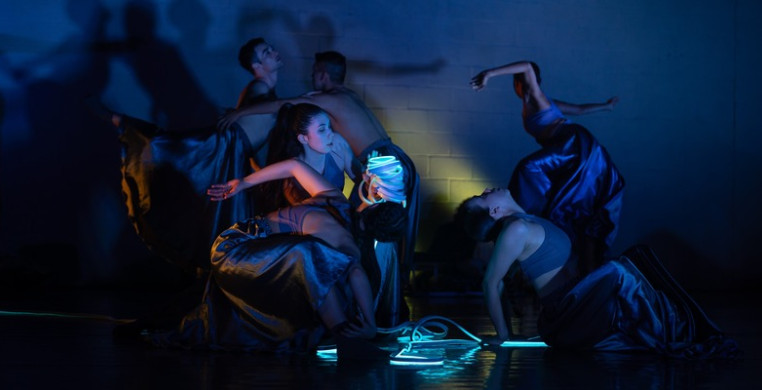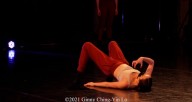UPDATE: The new seechicagodance.com will launch March 31st. Click here to learn more.
Lighting the way: Identity Performance Arts
The importance of lighting cannot be overstated. Its varying degrees in color, focus and intensity can enhance the atmosphere of a performance. However, achieving a balance between these elements can be challenging, as lighting must complement the piece’s movement, music, costumes and themes. Well-executed lighting often goes underappreciated, as it is meant to blend seamlessly within the performance; so when lighting is noticeable, it is usually for its faults.
This was not the case with the illuminating production of “Lights/9,” which was presented within the industrial-style space of the C5 Theater. Performed by Identity Performing Arts in collaboration with German light artist Franz Betz, the program celebrated light and experimented with incorporating the unique medium in dramatic ways to reflect various aspects of human emotion and nature.
Betz, renowned for his sculptural work with neon lights, rubber tubes, artificial turf, timber and metal grids—each maintaining a strong relationship with space, material and architecture—teamed up with Ginny Ching-Yin Lo, founder and director of Identity Performing Arts, to collaborate on the piece “Lights/9.”
The project was initially inspired by Ching-Yin Lo’s visit to Switzerland, where an exhibition of light installations captivated her, inspiring an improvisational dance that eventually became the foundation for the piece. With the help of Betz, the piece integrated nine elements of intertwining light movements with improvisational dance to explore the tension between appreciation and fixation.
A long bundle of rope, pulsing a gentle teal from its inner threads, laid tightly coiled at the center of the stage. The blue light illuminated the large space in a soft glow, evoking juxtaposing feelings between the calming color and the coiled pressure of the rope—the mixed potential of the new.
As seven dancers slowly filled the stage, they exhibited a childlike fascination with the spring of color. Often approaching slowly with an animalistic fear—with clawed hands, arched backs and tilted heads—they stretched and tangled themselves within the teal glow. As the rope unfurled and the movement of the dancers increased in intensity, the light shifted to an ominous red, as if the innocent curiosity of the dancers had morphed into an unhealthy obsession.
 "Lights/9," with Mark Gonzalez; Photo by Peter Hinsdale
"Lights/9," with Mark Gonzalez; Photo by Peter Hinsdale
This harmful fixation on the wonderful is shown to be cyclical as the red line became discarded—used, and therefore useless—for a second, undisturbed blue rope. That line, unfurled with the same frantic vigor, also became swallowed in red; a mirror for humanity's own infatuation for fast innovation.
Dancers had to work together to untangle one another from their self-made red bonds and, when freed, were able to manipulate and reconfigure the lines into new positions—working with the string, instead of exploiting and discarding, to find its true potential.
Utilizing the space and flexibility of the ropes, the dancers created crosses, boxes, corners, spirals, and aisles to create new boundaries. The color of the rope often changed, influencing the state of the movement surrounding these new shapes—red eliciting jerky jumps and twisting movement, blue prompting long extensions and slow port de bras and yellow a cheerful skip.
The dancers slowly reunite the two ropes, tentatively bundling the lines together in a swirling collision of teal and fuchsia. By restoring it to its original state, the dancers convey an understanding of the precious nature of this resource and demonstrate the importance of showing gratitude and respect for the things we use.
“Vicissitudes,” choreographed by Ching-Yin Lo, was created during the pandemic to express how the web of human connection helps us cope with stress. The piece was created in silence with music being composed from the dance itself by the experimental electronic duo, Chromobeats.
The piece, performed by Josephine Castillo, Amelia Harris, Audrey Hartnett and Hanley Simpson, focused on one dancer, Hartnett, as she wrestled with her inner state of mind. Her movements began uncertain and panicked, with quick jumps and isolated twists, while her dancer counterparts often contrasted her with slow legs and soft bows.
As the piece progressed, the lighting became more intense. With floor lights angled up at the dancers, multiple shadows became prominently projected onto the back wall. Hartnett often dominated the shadowy world, standing closer to the lights, trapped in her panic. Her large shadows, the strength of her anxiety clear to see in this veiled world, portrayed tortured movements and covered the softer shadows of reassurance from those around her.
It is only when Hartnett allows herself to be pulled out of her anxiety, accepting the comfort she desires, that her shadow settles and decreases in size. A battle finally made tolerable through the help of others.
Identity Performance Arts managed to make lighting the spotlight of their program. It was a visual feast for the eyes, a charming experience and an excellent way to close their spring season.
For more information about Identity Performing Arts, click the company link below.


